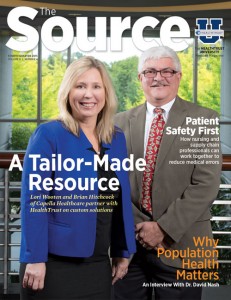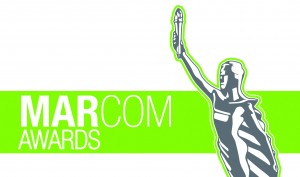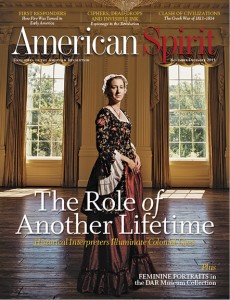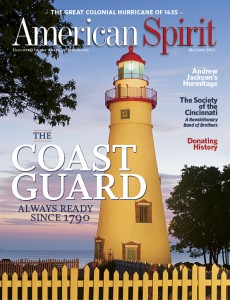


 Population health was foremost on our minds as we prepared the Q4 issue of The Source, the magazine we help HealthTrust publish for healthcare supply chain professionals. Healthcare systems and physicians groups are developing new programs aimed at population health management, a systematic approach to addressing the preventive, high-risk and chronic care needs of patients, with a goal of minimizing costly interventions like emergency room visits, hospitalizations and readmissions. We interview Dr. David Nash, of the Jefferson School of Population Health in Philadelphia, on this healthcare paradigm shift. As the founding dean of the first designated school of population health in the country, Nash is considered one of the leading experts in the field.
Population health was foremost on our minds as we prepared the Q4 issue of The Source, the magazine we help HealthTrust publish for healthcare supply chain professionals. Healthcare systems and physicians groups are developing new programs aimed at population health management, a systematic approach to addressing the preventive, high-risk and chronic care needs of patients, with a goal of minimizing costly interventions like emergency room visits, hospitalizations and readmissions. We interview Dr. David Nash, of the Jefferson School of Population Health in Philadelphia, on this healthcare paradigm shift. As the founding dean of the first designated school of population health in the country, Nash is considered one of the leading experts in the field.

Though we’re not going to dress up in fancy ballgowns or tuxes with Stetsons and hand-tooled boots like the folks at the CMA awards this week here in Nashville, we at Hammock are celebrating with our clients over a clutch of MarCom awards for the work we are honored to collaborate with our clients in creating.
The MarCom Awards is an international creative competition for anyone involved in the concept, writing and design of print, visual, audio and web materials and programs. The program is administered by AMCP, the Association of Marketing & Communication Professionals. There were about 6,000 entries this year from individuals to media conglomerates and Fortune 50 companies.
Here’s what was in the envelopes:

American Spirit* visited the American Village, a history and civics education center in Montevallo, Ala., for our November/December 2013 cover story profiling historical interpreters. (This editor grew up less than a mile away from the American Village, and it’s her family’s favorite spot for Fourth of July fireworks and other patriotic events.) The American Village re-enactors and others spotlighted in our story exhibit an extraordinary commitment to historical detail. That commitment to authenticity is best expressed by this quote from Patricia Bridgman, who plays Abigail Adams at Adams National Historical Park in Quincy, Mass., and at the Abigail Adams birthplace in Weymouth, Mass.
“I sweep my bangs up into a pompadour, eschew makeup, lace myself into stays, don a bum roll [a support, such as a hoop or pillow, worn under a skirt], petticoats and gown, along with silk stockings and reproduction shoes, and I’m ready to go,” Ms. Bridgman says. “The one question all re-enactors get is, ‘Aren’t you hot in that?’ The 21st-century answer is, ‘Damn straight,’ but Abigail says, ‘I am well accustomed to it, madam.’”
 Don’t you want to grab one of the crisp red apples that grace the cover of the September/October issue of American Spirit*? Our feature takes readers through the history of how apples became “our democratic fruit.” Just as they set down their own roots on American soil, settlers bringing seeds to the New World in 1620 carefully nurtured the fruit-bearing trees, and it wasn’t long before apples became a staple of the nation’s diet. Today they’re a unique symbol of our cultural heritage.
Don’t you want to grab one of the crisp red apples that grace the cover of the September/October issue of American Spirit*? Our feature takes readers through the history of how apples became “our democratic fruit.” Just as they set down their own roots on American soil, settlers bringing seeds to the New World in 1620 carefully nurtured the fruit-bearing trees, and it wasn’t long before apples became a staple of the nation’s diet. Today they’re a unique symbol of our cultural heritage.
Revolutionary spirit (often aided by a “flagon,” or pitcher, of apple cider) certainly was fomented in Colonial taverns. We talk with members of Flagon and Trencher, a lineage society that celebrates tavern keepers licensed prior to 1776 and honors their spicy ancestors’ unique contributions to the Revolution.
 In our May/June issue of American Spirit, the national magazine of the Daughters of the American Revolution (DAR)*, we remember an often-unsung branch of our Armed Forces: The United States Coast Guard. In our cover feature we detail the wide-ranging history of Coast Guard, which was originally created in 1790 to raise revenues and pull the nation out of debt. It has evolved into a guardian of our shores, a protector of our borders and an “Always Ready” life-saving service. As president George H.W. Bush said, “No branch of service has been in the business of saving lives longer than the Coast Guard. … No other branch does more to protect our environment. Few do as much to defend our homeland against the shadowy threats of illegal drugs and, now, terrorism. … This remarkable institution … is so clearly indispensable to America’s future.”
In our May/June issue of American Spirit, the national magazine of the Daughters of the American Revolution (DAR)*, we remember an often-unsung branch of our Armed Forces: The United States Coast Guard. In our cover feature we detail the wide-ranging history of Coast Guard, which was originally created in 1790 to raise revenues and pull the nation out of debt. It has evolved into a guardian of our shores, a protector of our borders and an “Always Ready” life-saving service. As president George H.W. Bush said, “No branch of service has been in the business of saving lives longer than the Coast Guard. … No other branch does more to protect our environment. Few do as much to defend our homeland against the shadowy threats of illegal drugs and, now, terrorism. … This remarkable institution … is so clearly indispensable to America’s future.”
Even with today’s high-tech weather radars and forecasting tools, extreme weather can uproot thousands of people, destroy homes and buildings and wreak havoc, as proven by the recent devastating tornadoes in Oklahoma and Hurricane Sandy on the East Coast. But what if such a storm came with absolutely no warning? That’s what happened in 1635,when a massive hurricane hit the coast of New England with winds estimated at 130 miles an hour, making it possibly the strongest hurricane ever to hit the region. Our feature shows how early Americans dealt with such severe weather events — and tried to make sense of the natural world.
Hammock provides content marketing services, which includes publishing print and digital magazines customized to meet our clients’ objectives. We study those objectives and work to ensure each issue of a client’s publication meets their specific goals. We accomplish this with expert writing about topics of interest to our clients’ target audience—and compelling design that brings to vivid life our writers’ stories. In the last month, these stories have included everything from historic re-enactors to the U.S. Marine Corps special ops and from the latest in pharmaceutical innovations to how health-care reform will affect supply chain managers. No matter the topic, our storytelling is tailored to the interests and passions of our clients’ customers and members. But we don’t just tell you that’s what we do—we’re always eager to show you. View our latest work for some of the publications we publish for our clients, including American Spirit, Semper Fi, The Source and Pharmaceutical Commerce.
Does good editing make a difference to people who receive your content? It does, according to a test run by IBM and reported at WritingforDigital.com.
Big Blue’s researchers took sample pages from the company’s site, gave them to an editor, and then randomly displayed both edited and unedited versions over the course of a month and measured “engagement” – defined as clicks to desired links on the page.
The edited pages got 30% higher engagement than the unedited ones.
While far from conclusive, the small test underscores the need to present not only content your readers will find interesting, but also to take time to craft and polish that content.
A side note: In referring to the editing of the Declaration of Independence, the writers are correct about the impact of changing one crucial word. But by all accounts, Thomas Jefferson felt each change personally, though he kept largely silent as the committee hashed over his comments. Your editor should always look at the work as a way to teach and improve your contributors’ writing, as a way to soothe ruffled feelings.
As mentioned here earlier, you’re knocking it out of the park if your readers and viewers eagerly await your latest update.
As described by Ardath Albee, “Contagious Content” is about your clients, customers and prospects – about what you can do and have done for them, not how much better than sliced bread your product or service is.
As Steven Covey would say, “Seek first to understand, then to be understood.”
Contagious content catches readers’ attention during that brief moment (about as long as it takes to sneeze) that they allot to decide whether it’s worth reading more. It’s also contagious because others may decide to pass it along via e-mail, Twitter or a blog.
You can make your content more contagious by following three basic steps:
* Define and refine search terms to improve your visibility
* Define and research your audience and their needs
* Using what you’ve learned, create compelling content that employs your optimum search terms.
Actually, there’s a fourth step: Analyze what works and what doesn’t, and further refine your search terms or your content or both. It’s an art, not an exact science, and it requires a commitment to improving your skills using what you’ve learned.
Writers and editors frequently need to find experts who can speak authoritatively on the subject of an article. Journalists who specialize in a given field soon accumulate a list of go-to gurus, but generalists don’t have that advantage.
Probably the first thing you try will be a direct online search. You may strike gold—especially in the sources cited by sites such as Wikipedia—or you may be overwhelmed with irrelevant sites. And even after refining your search, the results may still be ambiguous or less than solid.
Here are some suggestions for narrowing your search:
• Ask your editor for suggestions about experts.
• Run a search for other articles on the topic to see who’s been consulted previously, or, even better, experts who write on the topic.
• Blogs can be a good source of leads to experts. Similarly, Twitter may help you find people who post regularly on a given topic.
• Contact relevant professional or trade associations. The organization itself may include highly knowledgeable individuals, or they can direct you to members who are versed in the subject. Suite 101 also recommends consulting universities, whose faculty may be knowledgeable or can direct you to colleagues who can help.
• Websites such as Help A Reporter Out and Media Bistro serve as a crossroads for writers seeking information and public relations professionals and businesses eager to supply it. The Adventurous Writer recommends Prof.net as a source of professional experts.
• JournalismNet describes itself as “a free web site with over 600 pages … designed to bring you an investigative guide to the Internet – the best tools, tricks and websites from around the world.”
• Friends and colleagues may be able to help—writers and editors minds are attics where all sorts of odd facts lie waiting to be discovered.
Once you have a list of experts, take time to check them out online to see what others have said about them, such as possible biases. You may still use an expert with a known slant, but you will be able to include that as a caveat to your readers.
I won’t lie: When the Associated Press announced they were changing the entry in their stylebook from “Web site” to “website,” several of us here in the office danced a little happydance. Despite being users (and lovers) of AP style, that was one word we did not agree with them on.
Robert Niles of The Online Journalism Review explains the importance of the AP’s change in this recent blog post, referencing a tweet he made regarding the change: “If you’re publishing online, Google style (i.e. SEO) always trumps AP style.”
I don’t completely agree with Niles; I think it’s still important for journalism students to learn AP style. But it’s also important that they learn to write for the web.
People are using Google to look for your content, and if you’re still writing like you’re publishing a magazine or newspaper, by default you’re making it more difficult for Google to find you and, therefore, connect a potential client, customer or reader with your content.
That’s not to say that all AP style is Google offensive, because it’s not. But if you’re writing a piece for your website or blog, you can’t ignore what search engines look for. SEO (or “Internet marketing,” for those who think SEO is a negative term) isn’t just making sure you have your title and alt tags in place. It also involves using words and phrases that accurately describe what your article or blog post is about in a web-friendly way to help Google connect the right searchers to you.
Read more from OJR: The Online Journalism Review.